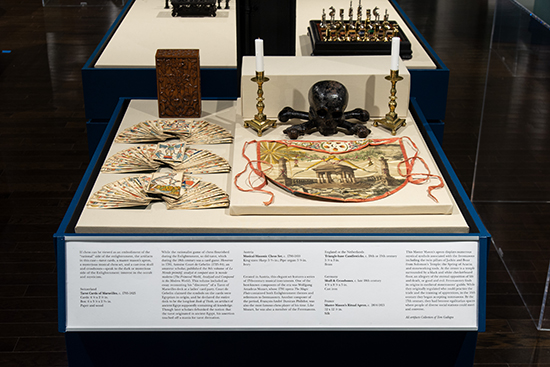—Alexa Clavijo
As I walk into the Dare to Know: Chess in the Age of Reason exhibition, I instantly feel surrounded by history. Even though I’m not a well-seasoned chess master, there are several unique chess sets and collectibles that catch my eye. As an artist, I am immediately drawn to the skillful craft and the aesthetics of the hand-carved chess sets. However, some of my favorite pieces in Dare to Know celebrate the wonder, mystery, and illusion of the Enlightenment.
In an occult-themed case is the “Tarot Cards of Marseilles,” a collection of time-worn cards from the turn of the 18th century used to predict the future. They feature a distinct, illustrative style deserving of appreciation. Even more impressive is the fact that, in addition to chess, Tarot proliferated the Enlightenment era. Much like chess’ duality, a game deep-seated in logic and rationality, Tarot offered a balance with its open-ended interpretations and mysticism.

Collection of Occult Objects from Dare to Know: Chess in the Age of Reason
Also included in the display is a beautifully ornate Freemasons apron, which would have been worn by a Master Mason while performing specific rites and ceremonies. Along with mystical symbols, an iconic black and white checkerboard pattern decorates the floor of a temple, and is considered a metaphor for the “eternal opposition of life and death.”
An adjacent vitrine contains artifacts that represent one of the greatest illusions from the Enlightenment, “The Mechanical Turk.” Also known as the “Automaton Chess Player,” the Turk was toured as a machine that played chess against human opponents. However, unbeknownst to the audience, the machine had a secret compartment underneath where a human chess player would track the moves of the opponent and articulate the Turk itself. Unfortunately, the original Turk was burned in a fire in 1854 but was later reconstructed in the 1980s, which I was able to see for myself at the Metropolitan Museum of Art. In the context of the time, it must have been thrilling to play against an “intelligent” machine, blurring the lines between illusion and reality.

Small Model of the Mechanical Turk
Chess’s influence during the Enlightenment goes far beyond its decorative and playful appearance and is much more than a board game. I am impressed that chess holds many philosophical interpretations, logical reasoning, and a world of wonder. “Dare to Know: Chess in the Age of Reason” is on view at the World Chess Hall of Fame through November 1, 2020, and is free and open to the public.
Alexa Clavijo is a Latinx artist based in St. Louis. He also works as a senior gallery attendant at the World Chess Hall of Fame. Clavijo assists with preparing artifacts for exhibits and works closely with colleagues on the museum’s installations.

